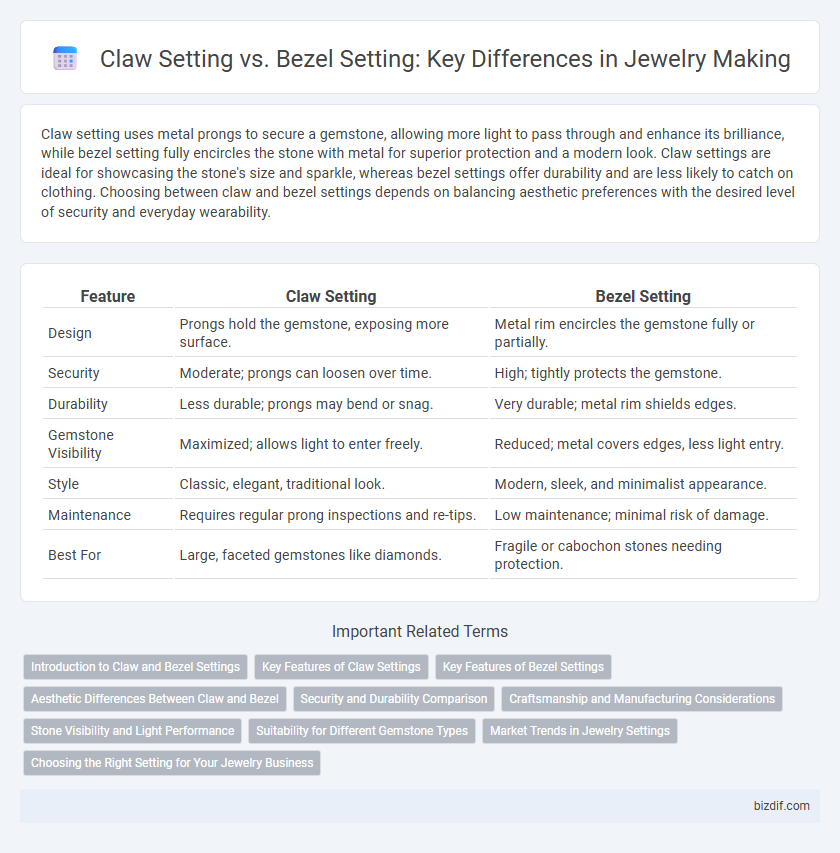Claw setting uses metal prongs to secure a gemstone, allowing more light to pass through and enhance its brilliance, while bezel setting fully encircles the stone with metal for superior protection and a modern look. Claw settings are ideal for showcasing the stone's size and sparkle, whereas bezel settings offer durability and are less likely to catch on clothing. Choosing between claw and bezel settings depends on balancing aesthetic preferences with the desired level of security and everyday wearability.
Table of Comparison
| Feature | Claw Setting | Bezel Setting |
|---|---|---|
| Design | Prongs hold the gemstone, exposing more surface. | Metal rim encircles the gemstone fully or partially. |
| Security | Moderate; prongs can loosen over time. | High; tightly protects the gemstone. |
| Durability | Less durable; prongs may bend or snag. | Very durable; metal rim shields edges. |
| Gemstone Visibility | Maximized; allows light to enter freely. | Reduced; metal covers edges, less light entry. |
| Style | Classic, elegant, traditional look. | Modern, sleek, and minimalist appearance. |
| Maintenance | Requires regular prong inspections and re-tips. | Low maintenance; minimal risk of damage. |
| Best For | Large, faceted gemstones like diamonds. | Fragile or cabochon stones needing protection. |
Introduction to Claw and Bezel Settings
Claw settings, also known as prong settings, use metal claws to securely hold a gemstone while maximizing its exposure to light for enhanced brilliance. Bezel settings encircle the gemstone with a continuous metal rim, offering superior protection and a sleek, modern appearance. Both settings serve distinct purposes in jewelry making, balancing aesthetic appeal and stone security.
Key Features of Claw Settings
Claw settings, also known as prong settings, securely hold gemstones using metal prongs that grip the stone tightly, allowing maximum light exposure for enhanced brilliance and sparkle. These settings are favored for their minimal metal coverage, which showcases the gemstone prominently while providing strong protection against displacement. Commonly crafted with four or six prongs, claw settings offer versatility in design and are ideal for solitaire rings and high-profile jewelry pieces.
Key Features of Bezel Settings
Bezel settings encircle the gemstone with a continuous metal rim, providing superior protection and security compared to claw settings. This design minimizes the risk of chipping or loosening, making it ideal for active lifestyles and everyday wear. The sleek, modern appearance of bezel settings also enhances the gemstone's shape and color, delivering a smooth and polished finish.
Aesthetic Differences Between Claw and Bezel
Claw settings feature prongs that elevate the gemstone, allowing maximum light exposure and enhancing brilliance with a delicate, airy appearance. Bezel settings encircle the stone with a metal rim, creating a sleek, modern look that offers a smooth and secure frame while subtly highlighting the gem's shape. The claw setting emphasizes sparkle and intricacy, whereas the bezel setting delivers a bold, contemporary aesthetic with greater metal coverage.
Security and Durability Comparison
Claw settings, featuring prongs that hold the gemstone securely, offer excellent visibility and light exposure but may be prone to snagging and require periodic inspection for loose claws. Bezel settings encircle the gem with a metal rim, providing superior protection against impacts, reducing the risk of stone loss, and enhancing overall durability. For active wearers, bezel settings deliver greater security and resilience, while claw settings prioritize aesthetic brilliance with moderate protection.
Craftsmanship and Manufacturing Considerations
Claw setting requires precise prong shaping and bending to securely hold the gemstone while allowing maximum light exposure, demanding skilled craftsmanship and careful metal manipulation. Bezel setting involves crafting a continuous metal rim around the stone, offering superior protection and durability, but requiring advanced metalworking techniques to ensure a tight, seamless fit. Manufacturing considerations include the choice of metal thickness and tool precision, with claw settings often favored for intricate designs and bezels for robust, modern aesthetics.
Stone Visibility and Light Performance
Claw setting offers maximum stone visibility by exposing more of the gem's surface, allowing greater light to enter and enhance the stone's brilliance and sparkle. Bezel setting surrounds the stone with a metal rim, reducing light exposure and slightly diminishing its brilliance but providing superior protection and a sleek appearance. Jewelers choose claw settings for optimal light performance and bezel settings for durability and a modern aesthetic.
Suitability for Different Gemstone Types
Claw setting is ideal for harder gemstones like diamonds and sapphires, allowing maximum light exposure to enhance brilliance. Bezel setting offers superior protection for softer or fragile gemstones such as opals and emeralds, encasing the stone securely to prevent damage. Both settings cater to different gemstone durability and aesthetic needs, influencing longevity and visual impact in jewelry design.
Market Trends in Jewelry Settings
Claw setting remains popular for its ability to showcase gemstones with maximum light exposure, appealing to modern consumers seeking vibrant sparkle and minimalist designs. Bezel setting is gaining traction in the market due to its robustness and sleek, contemporary appearance, favored for everyday wear and durability. Recent trends indicate a growing demand for personalized and secure settings, driving innovation in hybrid designs that combine the elegance of claw settings with the protection offered by bezels.
Choosing the Right Setting for Your Jewelry Business
Claw setting offers maximum light exposure and brilliance, ideal for showcasing diamonds and precious stones in high-end jewelry designs. Bezel setting provides robust protection and a sleek, modern look, making it suitable for everyday wear and custom pieces that prioritize durability. Selecting the right setting depends on balancing aesthetics, gemstone security, and target customer preferences to optimize product appeal and business growth.
Claw Setting vs Bezel Setting Infographic

 bizdif.com
bizdif.com